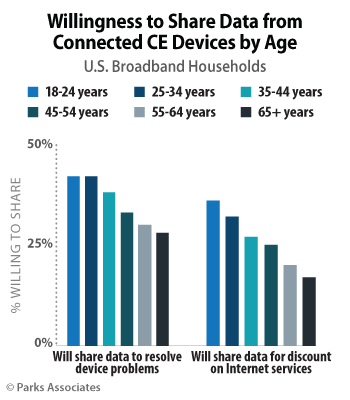Connected CE: Mining Customer Data and Consumer Concerns
 Mining customer data from connected devices is the new Holy Grail, and CE makers that mine customer information possess more revenue potential. Today, millions of televisions and other electronic devices record thousands of data points each day, automatically delivering them to manufacturers for analysis or for sale to third parties.
Mining customer data from connected devices is the new Holy Grail, and CE makers that mine customer information possess more revenue potential. Today, millions of televisions and other electronic devices record thousands of data points each day, automatically delivering them to manufacturers for analysis or for sale to third parties.
This is the new state of data gathering in the rapidly emerging Internet of Things (IoT), where virtually any connected device can gather and transmit data. The data gathered may be related to the quality of device performance—often referred to as telemetry data—media interaction data, or device usage patterns by owners.
Manufacturers analyze the data and correlate it with consumer profile information to develop more targeted sales messages, offer customized services, predict consumer behavior, or deliver fraud protection, in the case of credit card companies. When sold to third-party advertisers, the data is typically anonymized, stripped of personally identifiable information, though algorithms exist that can de-anonymize data by correlating data sets from different sources. Device data may also be used to improve product performance, to predict maintenance needs, and to inform the development of new products and services.
As the capacity for data gathering in the home is greatly expanded by virtue of a variety of sensors, video cameras, and inter-device data sharing, brands are required to carefully negotiate consumer concerns and the value propositions that data gathering offers them. While much concern is often theoretical about what could possibly happen, there have been enough anecdotal stories of hacked baby monitors, car controls, and home security cameras to elevate consumer concern and sensitivity to privacy issues. Almost one-half of broadband households have privacy or security concerns about one, or more, smart home devices (47%).
Where data gathering can be offered as a voluntary consumer transaction that results in compelling value, consumers can opt in or out. For consumers who value privacy more than customized services, data gathering may be considered a deal-breaker. Brands are exploring better ways to educate consumers on the value of data gathering that benefits them, while also offering more granular controls that provide consumers with transparency and choice.
Consumers are most willing to share data to resolve device problems, and secondarily, to receive discounts on Internet, mobile phone or related services. 42% of consumers ages 18-34 will share data to resolve device problems. 34% of ages 25-34 will share data for Internet or phone discounts.
Consumer willingness to share data for relevant reasons suggests a growing recognition of data as currency. Many will respond to clear, voluntary value propositions where data is exchanged for desirable benefits. Improved transparency and choice, comprehensible privacy policies, and better explanations of the value of data sharing will facilitate the growth of this data economy.
For more information on this research, see Parks Associates' industry report Connected CE: Trends and Innovation.
Further Reading:
- U.S. Ownership of Game Consoles to dip below 50% by 2019
- Innovations to Improve the Streaming Media Experience
- Privacy and Big Data: Safeguarding Consumers
Next: Consolidation in the TV Industry
Previous: European Consumer Adoption of Connected CE Devices
Comments
-
Be the first to leave a comment.
Post a Comment
Have a comment? Login or create an account to start a discussion.


